In order to create a corner of the underwater world at home, it is not enough to purchase an aquarium, you should also worry about its technical equipment. The tremendous choice of basic and auxiliary equipment for aquariums can plunge into confusion. In this article, we will talk about how to navigate in an abundance of filtering devices, compressors, cooling systems, lighting devices and so on.
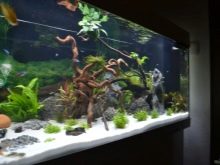
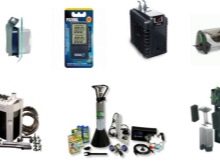
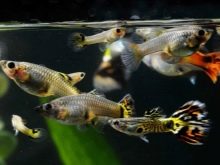
Types of filters, their pros and cons
By type of location, filtering devices for aquariums are:
- external (external);
- internal (submersible);
- mounted;
- bottom.

Submersible filtering devices are the most affordable, and therefore extremely popular. They are a pump that drives water through a filter element grouped with it in a common housing. As a filter element, foam sponges are used in them. In case of contamination, it is only necessary to rinse the sponge and put it in the filter.
The block of the filtering device is completely immersed in water and fixed by means of suction cups to the tank wall. If you are not satisfied with the appearance of the device in the aquarium, you can simply decorate it.
Indoor appliances are usually provided for containers of small or medium volume - from 20 to 150-200 liters. At times, they are used in large aquariums as auxiliary devices.
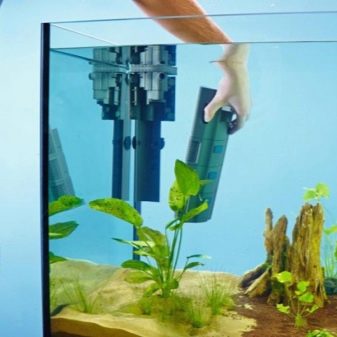
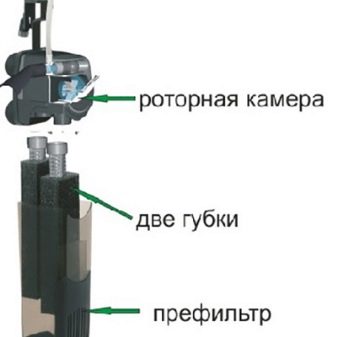
The bottom filtering device (or false) forms a fluid cycle in the soil, thus forming a beneficial microflora in it. There are 2 operating modes of the filtering device:
- the liquid medium after the cleaning phase is fed into the soil, leaving the upper layer of the aquarium;
- contaminated water from the aquarium is drawn into the filter through the ground.
The disadvantages of such devices are their low bandwidth and difficulty in maintenance. In large aquariums they are usually not used, however, this is ideal for a round aquarium.
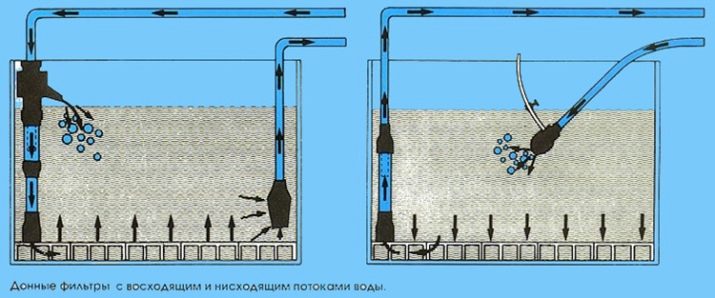
External filtering devices carry the possibility of filling with a variety of cleaning components to create optimal biofiltration. Their cost is significantly higher than that of other types of filtering devices, but the quality of cleaning is almost ideal (if fillers are used for biofiltration). They are less likely to need cleaning - usually no more than once every 2-3 months. To all their advantages, it is necessary to add that when cleaning the filter element, you do not need to invade the aquarium itself, since the apparatus is external.
Basically, the external device is used for large tanks - 150-300 liters or more. It has a much larger range of filter media and, therefore, is able to process a considerable amount of harmful components that appear in the aquarium during the life of its inhabitants.
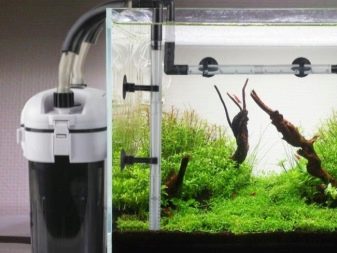
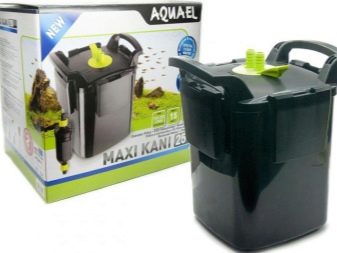
Mounted filtering devices operate quite silently, it is very easy to look after them. You just need to occasionally change the filler in them so that they function more efficiently.
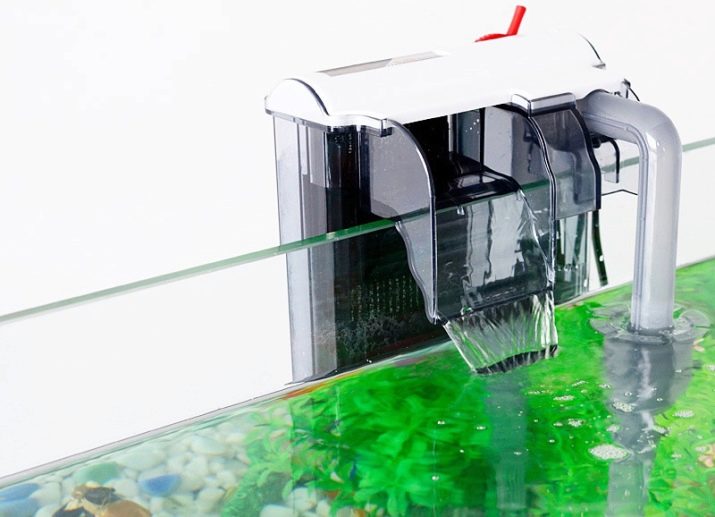
Compressor Equipment Overview
All fish need oxygen, so with a large concentration of inhabitants in the aquarium, the compressor is the second most necessary equipment for it.
Choosing a compressor, you need to focus on its productivity. This figure is based on the capacity of your tank. To calculate the required productivity, it is necessary to multiply the volume of liquid in the aquarium by a factor from 0.5 to 1 (depends on the variety of fish that will live in the aquarium).
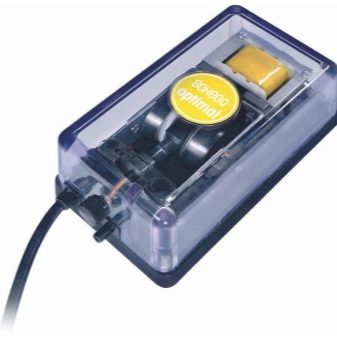
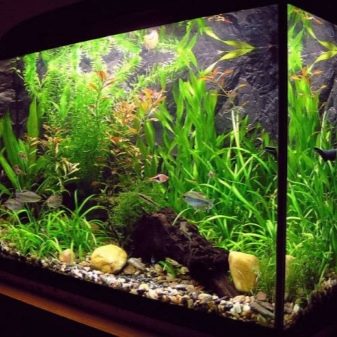
The compressor promotes fluid circulation and helps cool it in the heat. I must say that a compressor is not required in an aquarium with vegetation, sometimes it is even harmful, since it removes carbon dioxide from the liquid that plants need.
The most common type of compressor is outer, it does not require a place in the aquarium, it is not dangerous, but it constantly makes noise. Quiet submersible types of compressors, of course, occupy the space of the aquarium, but they are not so in demand.
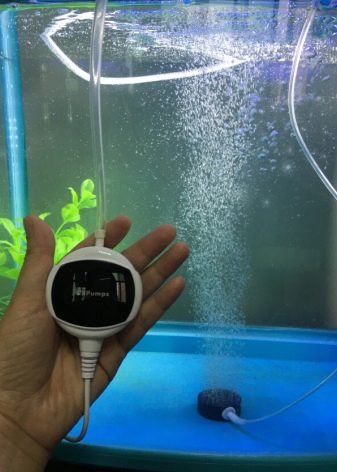
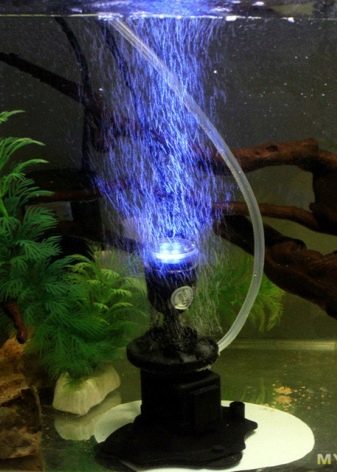
Water cooling system options
One of the most important tasks of an aquarist is to cool the water in the aquarium. There are 2 ways to technologically solve this problem.
Fans for cooling an aquarium
Usually they are blocks that include one or more fans. They are fixed to the wall of the tank and are directed at an angle to the surface.
Pros:
- take up little space;
- Do not use a lot of electricity;
- can be freely purchased at a relatively low cost (depending on version and type).
Minuses:
- increase the evaporation of the liquid, therefore it is often necessary to add water;
- can only be placed on an open type aquarium or you need to make a special cutout for the fan in the lid.

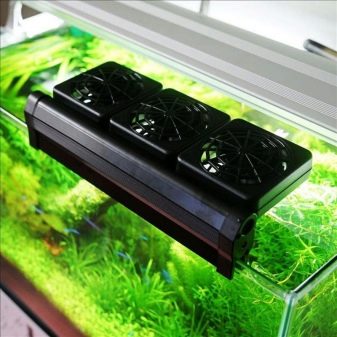
Fans are:
- unregulated - such devices can give extremely maximum power;
- with manual adjustment - in these samples you can lower or increase the blowing power yourself (for example, by means of the toggle switch) and thereby choose the optimal mode;
- absolutely controllable - with a temperature regulator at which the desired temperature is set, maintained in auto mode by repeated fan starts.
The temperature is reduced by cooling the surface of the liquid and its subsequent evaporation. So you can lower the temperature of the liquid in the tank by 2-4 ° C.
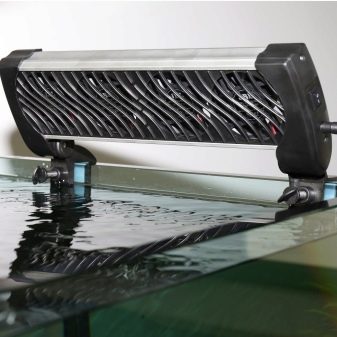

Aquarium Refrigerators
This is the most efficient refrigeration equipment.With a competent choice of the unit, it is able to lower the temperature by 10-20 degrees, which makes it possible not only to exclude problems associated with the temperature in the room, but also allows you to use it for breeding at home cold-water fish species living at a temperature of 8 to 14 ° WITH.
Aquarium refrigerators are connected either to an external filter, or through an individual pump, or cut into the track at the exit of the sump (a glass container connected to the aquarium).
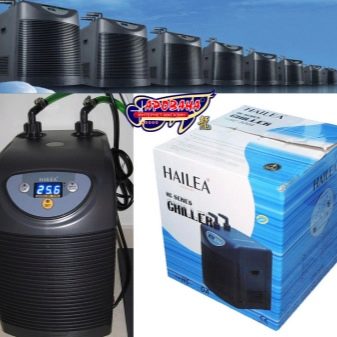

Pros - they can seriously cool the liquid, they are simply installed in the system, most of the modifications provide for regulation.
Minus is pretty expensive equipment that consumes a lot of electricity. It emits a lot of humidity and thermal energy depending on the type of installation, so do not put the refrigerator in an isolated and unventilated place (for example, in a tightly closed small bedside table).
There are 2 types of refrigerators.
- Freon. The liquid enters the unit through the intake pipe, goes through the system, cools, and exits through the exhaust pipe. A control system is installed in the unit, which determines the temperature of the liquid at the inlet to the unit and turns it off if it converges with the installed one or becomes lower. When installing the refrigerator, you need to carefully compare the power of the water flow and the system to the similarity indicated by the manufacturer, otherwise it can cause unproductive operation of the unit.
- Functional by spray cooling method. They are connected in the same way as freon ones, but they are cooled by a string of powerful fans.

Carbon dioxide supply
Carbon dioxide is needed for better development of plants in the aquarium. Plants take carbon from carbon dioxide, which is a key building material for their cells.
There are 3 methods for feeding carbon monoxide to a tank:
- fermentation;
- liquid gas cylinders;
- carbon-containing drugs.

In the first case, alcohol fermentation is used to supply carbon dioxide: yeast converts sugar into alcohol and simultaneously emit carbon monoxide. Commercially available fermenters consist of a sealed tank, a carbon monoxide feed device, and suction cup tubes.
This method is only good for small aquariums. The fermentation rate depends on the temperature, in addition, you need to always get relatively expensive ingredients. Sometimes it is necessary to insulate the tank, install it close to a warm aquarium or heating battery, since carbon monoxide is practically not released at temperatures below 20 ° C.

The second option for feeding carbon dioxide to the aquarium involves 2 methods:
- disposable carbon dioxide cylinders;
- refillable cylinders.
This is the most stable way to feed carbon dioxide into the tank. The simplest feed installation is equipped with the following elements:
- tubes;
- feed regulator;
- Check Valve;
- air distributor (flipper, diffuser);
- carbon dioxide cylinder.
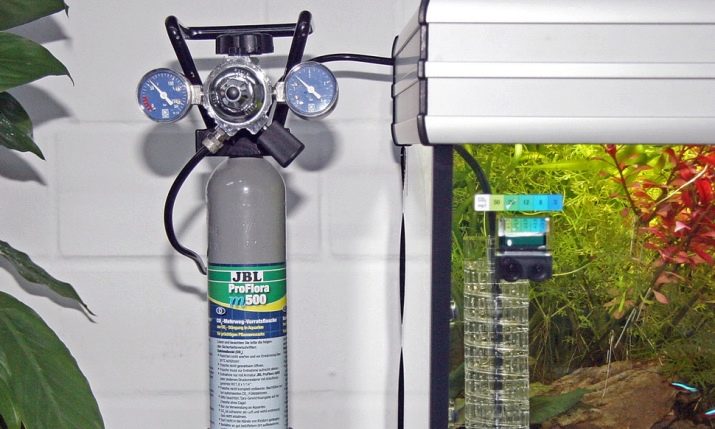
A pressure gauge is placed on the carbon dioxide cylinder, which displays the pressure in the cylinder connected to the shut-off valve. When opening or closing the shut-off valve, increase or decrease the flow of carbon dioxide.
The non-return valve prevents fluid from entering the tubes in the aquarium. Flipper breaks the incoming carbon dioxide into small bubbles. The smaller the bubbles the air distributor forms, the more rapidly carbon dioxide dissolves in the aquarium water and the higher the price of the air distributor.
The disadvantage of this installation is the high initial price, which pays off with prolonged use due to the cost-effectiveness of the feed technology. The assembled installation does not have carbon dioxide leaks through the connections of the nozzles and gearboxes.

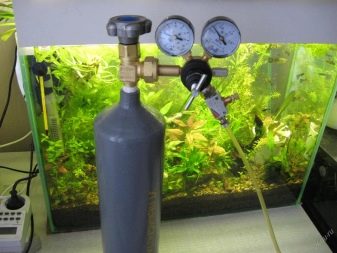
There are two more less popular methods for filling water with carbon monoxide:
- electrolytic;
- carbonate.
In the electrolytic method, carbon monoxide exits directly from the aquarium water through a carbon plate with an iron clamp and when a weak electric current is applied. The current strength is set by a transformer. The plate is hung in a water stream at the outlet of the filter device - so carbon dioxide is best distributed throughout the tank. With very soft water, you should be careful, as this device reduces the temporary stiffness.
The carbonator produces carbon dioxide from a saline solution of a weak dibasic acid through safe acids and a substance that accelerates the reaction. It is refueled once a month. This device is designed only for small aquariums up to 50 liters.
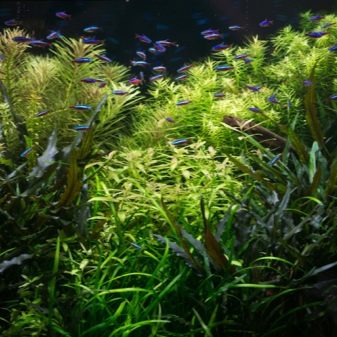
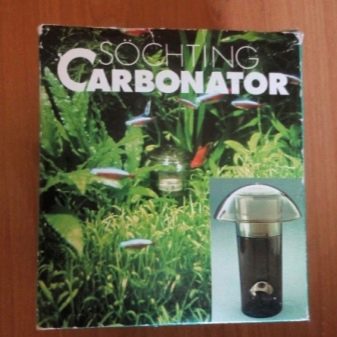
What should be the lighting?
Often aquariums are already sold with luminaires mounted in the lid. For ordinary aquariums, you can always find a suitable cover with bulbs or separately purchase a pendant or pendant lamp.
Basically, energy-saving, fluorescent, halogen, metal halide and LED bulbs are used as a light source in the aquarium.


The so-called calorimetric temperature of lamps, especially if you are going to settle live vegetation, which requires daylight with a temperature of 6500 to 8000 K. It must be said that a calorimetric temperature of less than 5000 K favors the growth of unnecessary algae.
Calculate the power of the bulbs according to the principle of at least 0.3 W per liter of liquid. For plant aquariums, the power should be higher (from 0.5 W per liter). Grass also needs light bulbs with a blue and red spectral range that improves growth and photosynthesis.
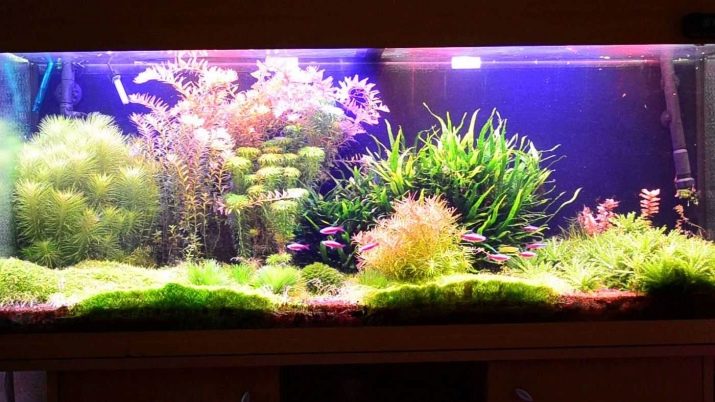
Additional accessories
Additional accessories may be in demand when cleaning and creating comfortable conditions for the inhabitants of the aquarium. These include:
- flute - to reduce the flow from the filter;
- feeders - there are dispensers and without them;
- nets - for catching and replanting fish;
- thermometers - to monitor the temperature of the water;
- cleaning kit - it includes a glass cleaner with a blade and a sponge;
- siphon for pumping water;
- jiggers for fish;
- means to destroy unnecessary algae.
In addition to key items, you may need different little things: scissors, scrapers, tweezers.
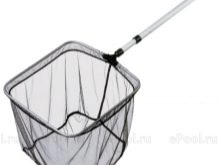
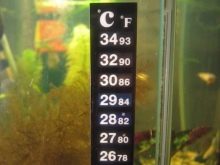
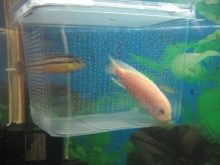
For what equipment is required for the aquarium, see the next video.










